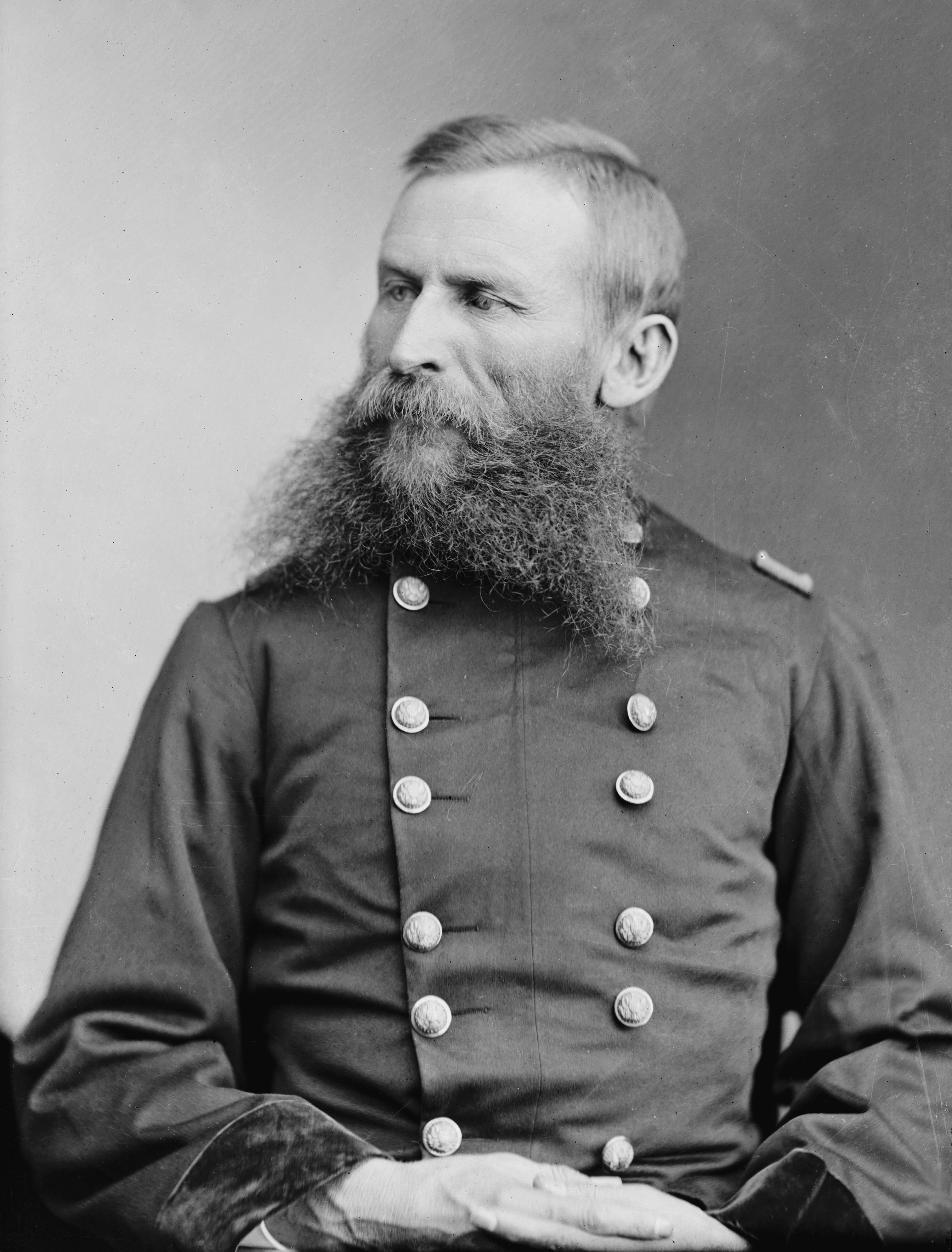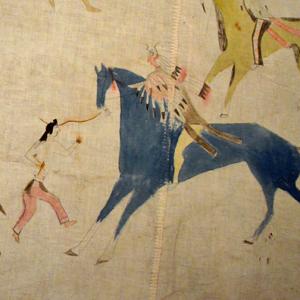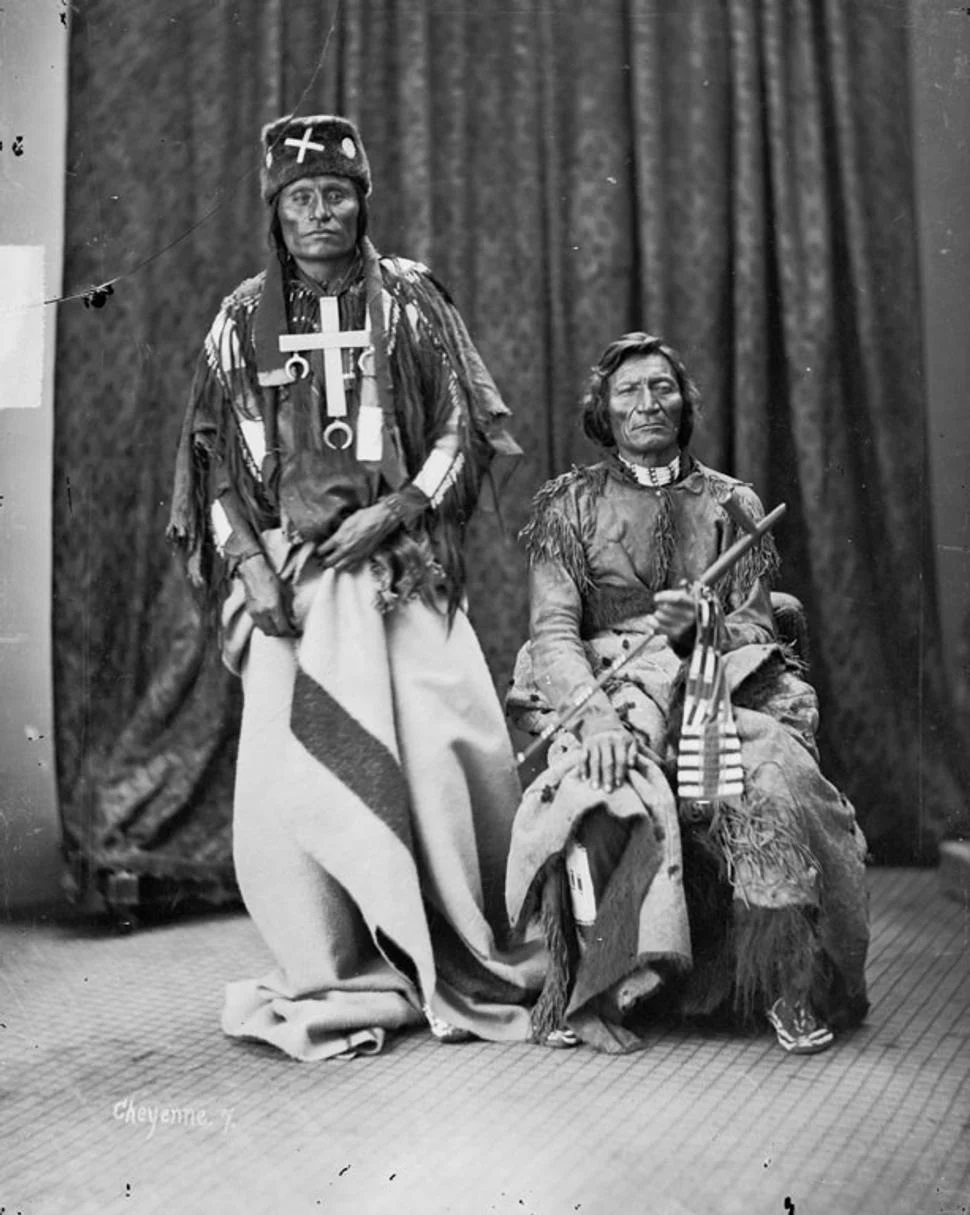|
Wooden Leg
Wooden Leg ( Cheyenne ''Kâhamâxéveóhtáhe'')''Kum-mok-quiv-vi-ok-ta'' in Marquis 1931pg. 3/ref> (c. 1858–1940) was a Northern Cheyenne warrior who fought against Custer at the Battle of the Little Big Horn. Early life Wooden Leg was born, in about 1858, in the region of the Black Hills, near the Cheyenne River. He was son of Many Bullet Wounds (also called White Buffalo Shaking off the Dust) and Eagle Feather on the Forehead. He had three brothers (the two elder ones being Strong Wind Blowing and Yellow Hair, the younger one Twin) and two sisters (the elder one being Crooked Nose, the younger one Fingers Woman). During his childhood, he was known as Eats from His Hand. Later, he inherited the name Wooden Leg from his uncle, a Crow adopted by the family of Eagle Feather on the Forehead. This young Crow proved to be a tireless walker, outlasting all the young Cheyenne and earning the name Wooden Leg, since his tireless legs seemed to be made of wood. Only his nephew was ... [...More Info...] [...Related Items...] OR: [Wikipedia] [Google] [Baidu] |
A Warrior Who Fought Custer
''Wooden Leg: A Warrior Who Fought Custer'' is a 1931 book by Thomas Bailey Marquis about the life of a Northern Cheyenne Indian, Wooden Leg, who fought in several historic battles between United States forces and the Plains Indians, including the Battle of the Little Bighorn, where he faced the troops of George Armstrong Custer. The book is of great value to historians, not only for its eyewitness accounts of battles, but also for its detailed description of the way of life of 19th-century Plains Indians. The book was dictated to Marquis by Wooden Leg in Plains Indian Sign Language, their only common language. Marquis gathered the stories for the book from Wooden Leg and others while he was physician at the agency in Montana from 1922. They were reluctant to open up to him at first, but eventually Marquis gained their trust. Wooden Leg lived through some of the most turbulent times in Cheyenne history, but the book begins with his childhood and descriptions of Cheyenne custo ... [...More Info...] [...Related Items...] OR: [Wikipedia] [Google] [Baidu] |
Battle Of The Rosebud
The Battle of the Rosebud (also known as the Battle of Rosebud Creek) took place on June 17, 1876, in the Montana Territory between the United States Army and its Crow Nation, Crow and Shoshone, Shoshoni allies against a force consisting mostly of Lakota people, Lakota Sioux and Northern Cheyenne Native Americans in the United States, Indians during the Great Sioux War of 1876. The Cheyenne called it the Battle Where the Girl Saved Her Brother because of an incident during the fight involving Buffalo Calf Road Woman. General George Crook's offensive was stymied by the Indians, led by Crazy Horse, and he awaited reinforcements before resuming the campaign in August. Background After their victory in Red Cloud's War and with the signing of the Treaty of Fort Laramie (1868), the Lakota and their Northern Cheyenne allies were allocated a reservation including the Black Hills, in Dakota Territory and a large area of unceded territory in what became Montana and Wyoming. Both areas we ... [...More Info...] [...Related Items...] OR: [Wikipedia] [Google] [Baidu] |
Tongue River (Montana)
The Tongue River is a tributary of the Yellowstone River, approximately 265 mi (426 km) long, in the U.S. states of Wyoming and Montana. The Tongue rises in Wyoming in the Big Horn Mountains, flows generally northeast through northern Wyoming and southeastern Montana, and empties into the Yellowstone River at Miles City, Montana. Most of the course of the river is through the beautiful and varied landscapes of eastern Montana, including the Tongue River Canyon, the Tongue River breaks, the pine hills of southern Montana, and the buttes and grasslands that were formerly the home of vast migratory herds of American bison. The Tongue River watershed encompasses parts of the Cheyenne and Crow Reservations in Montana. The headwaters lie on the Bighorn National Forest in Wyoming, and the watershed encompasses the Ashland Ranger District of the Custer National Forest. The river's name corresponds to Cheyenne ''/vetanoveo'he/'', where ''/vetanove/'' means "tongue" and ''/o'he' ... [...More Info...] [...Related Items...] OR: [Wikipedia] [Google] [Baidu] |
Lakota People
The Lakota (; or ) are a Native Americans in the United States, Native American people. Also known as the Teton Sioux (from ), they are one of the three prominent subcultures of the Sioux people, with the Eastern Dakota (Santee) and Western Dakota (). Their current lands are in North Dakota, North and South Dakota. They speak — the Lakota language, the westernmost of three closely related languages that belong to the Siouan languages, Siouan language family. The seven bands or "sub-tribes" of the Lakota are: * (, Burned Thighs) * ("They Scatter Their Own") * (, Without Bows) * (Hunkpapa, "End Village", Camps at the End of the Camp Circle) * (Miniconjou, "Plant Near Water", Planters by the Water) * ("Blackfeet" or "Blackfoot") * (Two Kettles) Notable Lakota persons include (Sitting Bull) from the , (Touch the Clouds) from the Miniconjou; (Black Elk), (Red Cloud), and (Billy Mills), all ; (Crazy Horse) from the and Miniconjou, and (Spotted Tail) from the ... [...More Info...] [...Related Items...] OR: [Wikipedia] [Google] [Baidu] |
Santee Sioux
The Dakota (pronounced , or ) are a Native American tribe and First Nations band government in North America. They compose two of the three main subcultures of the Sioux people, and are typically divided into the Eastern Dakota and the Western Dakota. The four bands of Eastern Dakota are the , , , and and are sometimes referred to as the Santee ( or ; 'knife' + 'encampment', 'dwells at the place of knife flint'), who reside in the eastern Dakotas, central Minnesota and northern Iowa. They have federally recognized tribes established in several places. The Western Dakota are the Yankton, and the Yanktonai ( and ; "Village-at-the-end" and "Little village-at-the-end"), who reside in the Upper Missouri River area. The Yankton-Yanktonai are collectively also referred to by the endonym ('Those Who Speak Like Men'). They also have distinct federally recognized tribes. In the past the Western Dakota have been erroneously classified as Nakota, who are located in Montana and across ... [...More Info...] [...Related Items...] OR: [Wikipedia] [Google] [Baidu] |
Sans Arcs
The Sans Arc or Itázipčho are one of the seven subdivision of the Lakota people. They primarily live in the Cheyenne River Indian Reservation in South Dakota. Name ''Itázipčho'' is also written ''Itazipcola'' or ''Hazipco'' and is a Lakota term translating as "those who hunt without bows." ''Sans Arc'' is the French translation, meaning "without bows". The translator of '' Wooden Leg: A Warrior Who Fought Custer'' renders the name as Arrows all Gone. One of the many etymologies of the Lakota name tells the following story: The true meaning of ''Itazipacola'' is "no markings". This referred to the fact that the ''Itazipco'' were so generous they did not mark their arrows (they were usually marked so that braves could claim the bison they killed, etc.), that way everyone could share the meat of the hunt. This is why when the Creator wanted to give the pipe to the ''Lakota'', the White Buffalo Woman ''Wopi'' brought it to the ''Itazipco'', because they would always be willing ... [...More Info...] [...Related Items...] OR: [Wikipedia] [Google] [Baidu] |
Miniconjou
The Miniconjou (Lakota: Mnikowoju, Hokwoju – ‘Plants by the Water’) are a Native American people constituting a subdivision of the Lakota people The Lakota (; or ) are a Native Americans in the United States, Native American people. Also known as the Teton Sioux (from ), they are one of the three prominent subcultures of the Sioux people, with the Eastern Dakota (Santee) and Western D ..., who formerly inhabited an area in western present-day South Dakota from the Black Hills in to the Platte River. The contemporary population lives mostly in west-central South Dakota. Perhaps the most famous Miniconjou chief was Touch the Clouds. Historic Miniconjou thiyóšpaye or bands Together with the Sans Arc (''Itázipčho'', ''Itazipcola'', ''Hazipco'' – ‘Those who hunt without bows’) and Two Kettles (''Oóhe Núŋpa'', ''Oóhenuŋpa'', ''Oohenonpa'' – ‘Two Boiling’ or ‘Two Kettles’) they were often referred to as ''Central Lakota'' and divided into sev ... [...More Info...] [...Related Items...] OR: [Wikipedia] [Google] [Baidu] |
Oglala Sioux
The Oglala (pronounced , meaning 'to scatter one's own' in Lakota) are one of the seven subtribes of the Lakota people who, along with the Dakota, make up the Očhéthi Šakówiŋ (Seven Council Fires). A majority of the Oglala live on the Pine Ridge Indian Reservation in South Dakota, the eighth-largest Native American reservation in the United States. The Oglala are a federally recognized tribe whose official title is the called the Oglala Sioux Tribe of the Pine Ridge Reservation, South Dakota. History Oglala elders relate stories about the origin of the name "Oglala" and their emergence as a distinct group, probably sometime in the 18th century. Conflict with the European settlers In the early 19th century, Europeans and American passed through Lakota territory in increasing numbers. They sought furs, especially beaver fur at first, and later bison fur. The fur trade changed the Oglala economy and way of life. In 1868, the United States and the Great Sioux Nation si ... [...More Info...] [...Related Items...] OR: [Wikipedia] [Google] [Baidu] |
Little Wolf
Little Wolf (, sometimes transcribed ''Ohcumgache'' or ''Ohkomhakit'', more correctly translated Little Coyote, 18201904) was a Northern Só'taeo'o Chief and Sweet Medicine Chief of the Northern Cheyenne. He was known as a great military tactician and led a dramatic escape from confinement in Oklahoma back to the Northern Cheyenne homeland in 1878, known as the Northern Cheyenne Exodus. Overview Born in present-day Montana, by the mid-1840s, Little Wolf had become a prominent chieftain of the Northern Cheyenne, leading a group of warriors called the " Elk Horn Scrapers" during the Northern Plains Wars. He fought in Red Cloud's War, the war for the Bozeman Trail, which lasted from 1866 to 1868. As chief, he signed the Treaty of Fort Laramie. He was chosen one of the "Old Man" chiefs among the Council of Forty-four, a high honor in traditional Cheyenne culture. He was also chosen as Sweet Medicine Chief, bearer of the spiritual incarnation of Sweet Medicine, a primary culture ... [...More Info...] [...Related Items...] OR: [Wikipedia] [Google] [Baidu] |
Ranald S
Ranald is a Scots and English Hanks; Hodges 2006 pp. 407–408; Hanks; Hodges 2003; Hanks; Hodges 1997 pp. 204, 205. masculine given name. It is an Anglicised form of the Scottish Gaelic Scottish Gaelic (, ; Endonym and exonym, endonym: ), also known as Scots Gaelic or simply Gaelic, is a Celtic language native to the Gaels of Scotland. As a member of the Goidelic language, Goidelic branch of Celtic, Scottish Gaelic, alongs ... name '' Raghnall,'' and a Scots version of ''Ronald.'' A short form of ''Ranald'' is ''Ran''. Hanks; Hodges 2003; Hanks; Hodges 1997 p. 205. Notable persons * Ranald Graham (1941–2010), Scottish writer, television director and producer * Ranald MacDonald (bishop) (1756–1832), Scottish Roman Catholic bishop * Ranald George Macdonald (1788–1873), Scottish clan chief and Member of British Parliament * Ranald MacDonald (1824–1894), English language teacher in Japan * Ranald Roderick Macdonald (1945–2007), British mathematician ... [...More Info...] [...Related Items...] OR: [Wikipedia] [Google] [Baidu] |
Morning Star (chief)
Morning Star (; also known by his Lakota Sioux name ''Tȟamílapȟéšni'' or its translation, Dull Knife) (c. 1810–1883) was a great chief of the Northern Cheyenne people and headchief of the ''Notameohmésêhese'' ("Northern Eaters"; also simply known as ''Ȯhmésėhese'' or "Eaters") band on the northern Great Plains during the 19th century. He was noted for his active resistance to westward expansion and the United States federal government. It is due to the courage and determination of Morning Star and other leaders that the Northern Cheyenne still possess a homeland in their traditional country in present-day Montana. Although he was known as "Dull Knife" (or ''Motšêške Ôhnêxahpo'' in Cheyenne, a translation of his Lakota name) to local settlers, U.S. military leaders, and other American Indians, his Cheyenne name is translated as "Morning Star". A Cheyenne warrior in every sense of the word, Morning Star was described by many writers of the era as "an admirable outla ... [...More Info...] [...Related Items...] OR: [Wikipedia] [Google] [Baidu] |
American Indian Wars
The American Indian Wars, also known as the American Frontier Wars, and the Indian Wars, was a conflict initially fought by European colonization of the Americas, European colonial empires, the United States, and briefly the Confederate States of America and Republic of Texas against various Tribe (Native American), American Indian tribes in North America. These conflicts occurred from the time of the earliest colonial settlements in the 17th century until the end of the 19th century. The various wars resulted from a wide variety of factors, the most common being the desire of settlers and governments for Indian tribes' lands. The European powers and their colonies enlisted allied Indian tribes to help them conduct warfare against each other's colonial settlements. After the American Revolution, many conflicts were local to specific states or regions and frequently involved disputes over land use; some entailed cycles of violent reprisal. As American pioneer, American settlers s ... [...More Info...] [...Related Items...] OR: [Wikipedia] [Google] [Baidu] |







